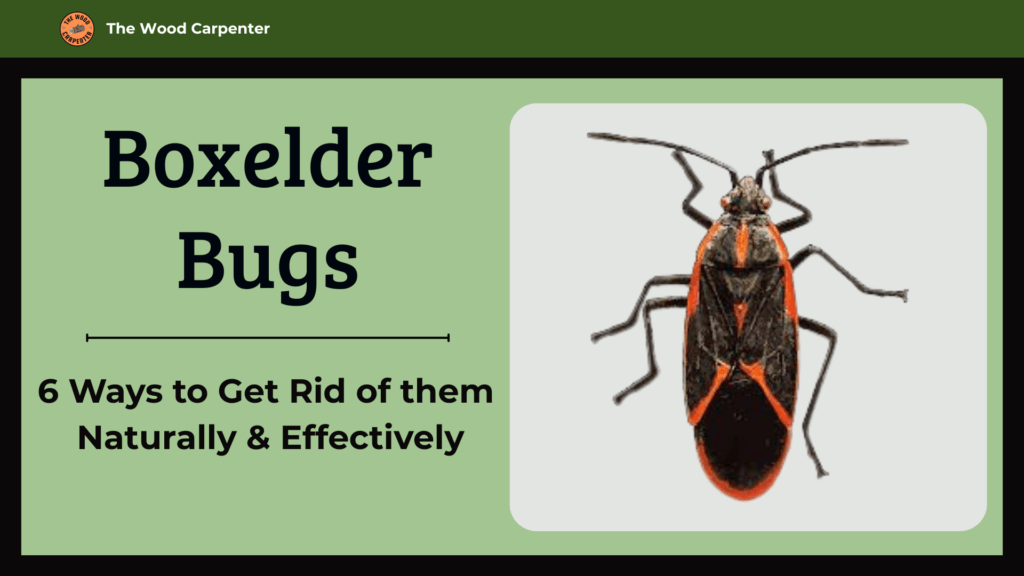
If you have ever seen a black bugs with red-orange stripes gathering on the sunny walls in your home during the fall, then the chances are they are boxelder bugs. Usually they do not bite, they don’t spread disease, and they won’t chew through your furniture. But let’s be honest here — they can feel like an invasion when they show up in swarms.
Good news is you don’t have to live with them! By taking steps such as prevention, simple home remedies and regular maintenance you can keep the boxelder bugs at bay without stressing out every fall season.
Here are six effective solutions to rid boxelder bugs–taken from advice of professionals, homeowners and even my own neighbors.
1. Seal Every Crack Before They Sneak In
These Boxelder bugs are the masters of slipping through the tiny gaps. They find entry through cracks around windows, gaps under doors, and spaces around siding – the first step in stopping them is sealing their entry points.
- Install fresh weatherstripping around doors.
- Repair or replace torn window screens.
- Use clear silicone or caulk to fill small cracks in siding, soffits, and around utility lines.
- For extra protection add door sweeps to exterior doors.
Consider it as protecting your home against bugs before the season even starts, because once they get inside it will become much harder to rid yourself of them.
2. Vacuum—Don’t Squash
The temptation is real — when you see boxelder bugs crawling across your walls and carpets and your first instinct is to squash them. Don’t. Crushing boxelder bugs releases foul odors and creates permanent stains in walls or carpets. Instead, take steps such as vacuuming for effective solution.
A regular household vacuum works just fine; for larger clusters of debris however, a shop vac is even better.
Quick tip: For best results when using a bagged vacuum, be sure to dispose of its bag immediately upon completion of use. With bagless vacuums, empty and rinse out the dust chamber outside – otherwise any escapees may find their way back inside!
3. Use a Soapy Water Spray
One of the simplest home remedies—and honestly, my favorite one is a spray bottle which is filled with water and dish soap. Mix about one tablespoon of dish soap per quart of water, shake it up, and then you must spray it directly on the bugs.
Here’s why it works: the soap will break down the waxy coating on their bodies, which will cause them to dry out and die.
You can also keep a bucket of soapy water outside and knock the clusters of bugs into it. They’ll drown quickly without you needing harsh pesticides.
It’s cheap, safe, and surprising effective!
4. Try Rubbing Alcohol for Instant Results
If you want something a bit stronger than the soap, 91% rubbing alcohol works like a charm. Simply spray directly on them, and they should die almost instantly!
Of course, be careful because rubbing alcohol is flammable. Don’t spray it near open flames or use it on delicate surfaces like painted wood or upholstery. But if you’ve got bugs crawling on your porch or siding, then this is a quick fix.
5. Remove What Attracts Them
The “boxelder” in their name isn’t just for show. These bugs are obsessed with boxelder trees (a type of maple). They also feed on seeds and leaves from maple and ash trees.
Now, you don’t necessarily have to chop down trees in your yard, but here’s what you can do:
- Rake up the fallen leaves and then seed pods regularly.
- Keep your yard tidy because these boxelder bugs love hiding in the piles of wood, leaves, or stones.
- If you do have a boxelder tree close to your house and then the problem is overwhelming, consider replacing it with a less attractive species.
By removing the food and shelter sources, you make your property less inviting for them.
6. Call in Professional Help (When It’s Out of Control)
Sometimes, despite your best efforts, boxelder bugs show up in numbers you can’t manage. When they’re clustering by the hundreds on your siding, or finding their way into your attic year after year, it may be time to call a pest control professional.
Pros can apply residual insecticides around the perimeter of your home—especially before bugs start moving inside for the winter. They’ll also identify weak spots you might have missed in your DIY sealing efforts.
Think of professional treatment as your last line of defense, especially if you’ve tried everything else and the bugs still keep coming back.
Real Talk: Living with Boxelder Bugs
Here’s the truth: You may never eliminate boxelder bugs 100%. They can travel from neighboring trees, and even if you seal your home perfectly, one or two might still find a way in.
But what you can do is reduce their numbers dramatically. My own neighbor had them all over her sunny garage wall every fall. After sealing cracks, adding new door sweeps, and keeping up with the soap spray, she went from swarms of hundreds to just a handful. That’s a win in my book.
It’s not about perfection—it’s about control.
Boxelder Bugs FAQs
1. Are boxelder bugs considered real pests?
Not really. Unlike termites or cockroaches, boxelder bugs don’t damage homes or contaminate food. They’re more of a nuisance because they gather in large swarms.
2. Why do boxelder bugs sit on the sunny side of my house?
Boxelder bugs are attracted to the warmth and light. That’s why you will often see them clustering on south or the west facing walls that get plenty of afternoon sun.
3. What trees attract boxelder bugs the most?
Boxelder trees attract them most; however, they also feed on seeds and foliage from maple and ash trees which could increase your chance of infestation.
4. Where do boxelder bugs hide in the winter?
In fall, boxelder bugs look for warm, sheltered spots to survive the cold months. Common hideouts include your attics, wall voids, garages, and sheds.
5. Do boxelder bugs smell bad?
Yes. When they are crushed, they release a foul odor and it can leave behind reddish stains on your walls, fabrics, and carpets. That’s why vacuuming is a better method for removal.
6. Are boxelder bugs dangerous to humans or pets?
No. They don’t bite, sting, or spread disease. At worst, handling them roughly might cause mild skin irritation.
7. How long do boxelder bugs live?
Boxelder bugs can live up to a year if they find suitable shelter during winter.
8. When are boxelder bugs most active?
They’re most noticeable in late fall, when large numbers gather on sunny walls before trying to move indoors for winter.
9. How can I identify a boxelder bug?
They have black bodies with bright red or orange markings, which makes them easy to tell apart from other nuisance bugs.
10. Do pesticides work against boxelder bugs?
Not particularly, as over time these insects have developed resistance to many conventional sprays. Natural remedies like soap and water sprays or professional treatments tend to be more efficient in fighting this pest.
11. What time of year are they worst?
Fall is their busiest season. As temperatures cool off, large flocks gather on sunny walls before moving inside for winter.
12. What do boxelder bugs eat ?
Boxelder bugs feed mainly on the seeds and sap of boxelder trees. They also suck juices from maples, ash, and fruit plants like apple and cherry, but cause little damage.
Disclaimer
We earn from qualifying Amazon purchases made via links on this site with no extra cost to you.

